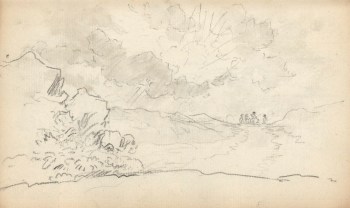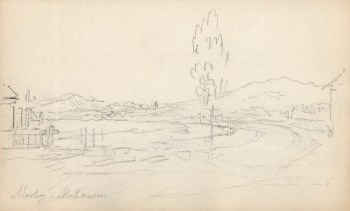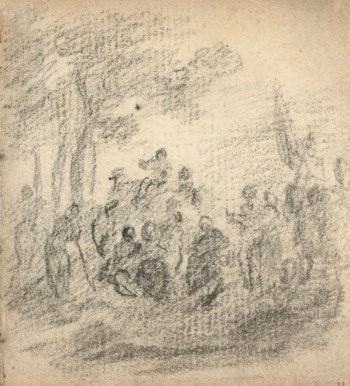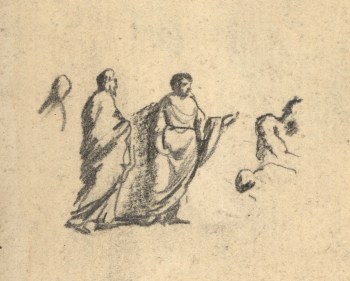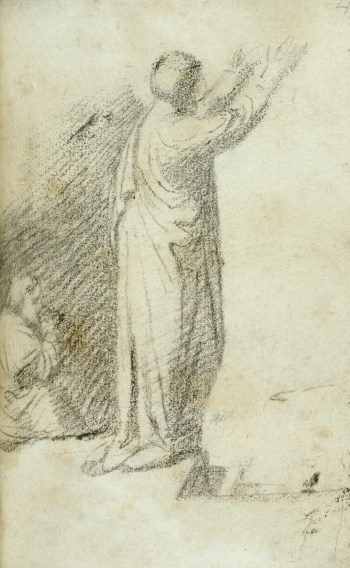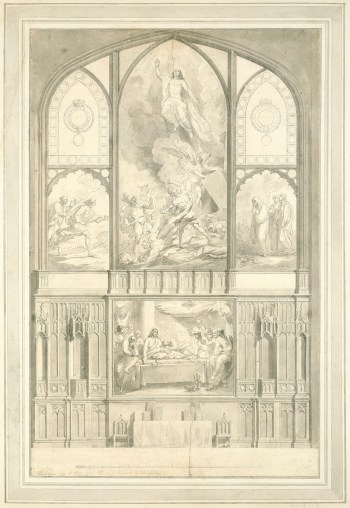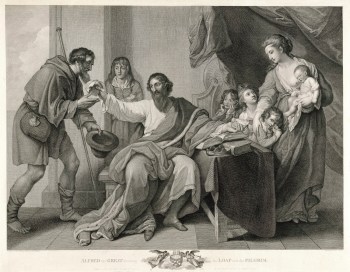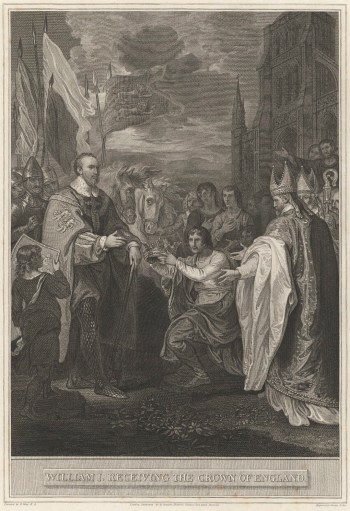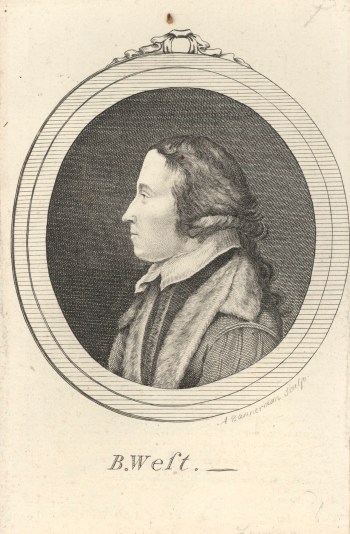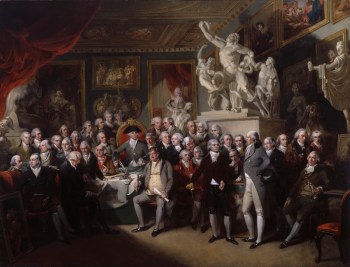Benjamin West PRA (1738 - 1820)
RA Collection: People and Organisations
A Founder member of the Royal Academy who became its second president, Benjamin West was an American artist who arrived in London aged 25 and decided to stay.
Born in Pennsylvania in 1738, Benjamin West developed an interest in art at a young age. Despite having little formal training he managed to establish himself as a portrait painter in Philadelphia and won the support of local patrons who funded his travel to Europe, making him the first American artist to visit Italy. West spent three years copying masterpieces by Titian, Raphael and others before arriving in London. He planned to visit Britain briefly before returning to America, but ended up staying for the rest of his life.
West quickly established friendships with a number of influential Londoners and secured the patronage of the Archbishop of York who in turn introduced him to King George III. In 1768, West joined Reynolds and other leading artists and architects in an appeal to the King for support in establishing the Royal Academy of Arts. The King agreed and the Academy was founded in December that year with Reynolds as President.
In 1771, West exhibited The Death of General Wolfe at the Royal Academy’s annual exhibition. The work was innovative in presenting a relatively recent event - the 1759 Battle of Quebec – in the manner of a classical history painting. Controversially, West depicted the figures wearing modern military uniform rather than classical robes. An engraving of the painting allowed reproductions to be sold and it became one of the most commercially successful prints ever published.
The following year, King George III made West his official history painter. Over the next few decades West completed a number of major paintings of historical, mythological and religious scenes, including subjects reflecting his American roots like Penn’s Treaty With The Indians. When Reynolds died in 1792, West was elected the second president of the Royal Academy. The King offered him a knighthood but West turned it down, apparently in the mistaken belief that he might be offered a peerage instead.
In 1802, when the Treaty of Amiens halted the Napoleonic Wars between Britain and France, West visited France and exhibited his Death on a Pale Horse in the Paris Salon. It was seen by Napoleon, who admired it and met briefly with West. This trip proved costly for the artist though as, afterwards, he fell out of favour with King George III who cancelled his annual stipend along with a prestigious commission.
West briefly resigned as President of the RA in 1805 and was replaced by the architect James Wyatt, but within a year, Wyatt had conceded the presidency back to West. In his later years, West often painted religious works, including Christ Healing the Sick, commissioned by a Quaker hospital back in Philadelphia. He also collaborated with the author John Galt on a biography that presents him as a self-taught master and devoted royal subject. West died in 1820 and is buried in St Paul’s Cathedral.
Profile
Foundation Member
Born: 10 October 1738 in Springfield, Pennsylvania, United States
Died: 11 March 1820
Nationality: American
Elected RA: 10 December 1768
President from: 1792 - 1805, 1806 - 1820
Gender: Male
Preferred media: Painting
Works by Benjamin West in the RA Collection
61 results
-
![Benjamin West PRA, Leaf from a sketchbook with a drawing of Shakespeare cliff, Dover]()
Benjamin West PRA
Leaf from a sketchbook with a drawing of Shakespeare cliff, Dover, 1802
Pencil on laid paper
-
![Benjamin West PRA, Leaf from a sketchbook with a landscape drawing]()
Benjamin West PRA
Leaf from a sketchbook with a landscape drawing, 1802
Pencil and wash on laid paper
-
![Benjamin West PRA, Leaf from a sketchbook with a drawing of a horse's head]()
Benjamin West PRA
Leaf from a sketchbook with a drawing of a horse's head, 1802
Pencil on laid paper
-
![Benjamin West PRA, Leaf from a sketchbook with a landscape view from Madame du Barry's villa]()
Benjamin West PRA
Leaf from a sketchbook with a landscape view from Madame du Barry's villa, 1802
Pencil on laid paper
-
![Benjamin West PRA, Leaf from a sketchbook with a drawing of Marly-le-Roi]()
Benjamin West PRA
Leaf from a sketchbook with a drawing of Marly-le-Roi, 1802
Pencil and black chalk on laid paper
-
![Benjamin West PRA, Leaf from a sketchbook with drawings of figures on a road]()
Benjamin West PRA
Leaf from a sketchbook with drawings of figures on a road, 1802
Pencil and grey wash on laid paper
-
![Benjamin West PRA, Leaf from a sketchbook with a drawing of a man on horseback]()
Benjamin West PRA
Leaf from a sketchbook with a drawing of a man on horseback, 1802
Pencil and grey wash on laid paper
-
![Benjamin West PRA, Leaf from a sketchbook with a drawing of a man on horseback]()
Benjamin West PRA
Leaf from a sketchbook with a drawing of a man on horseback, August 1802 - October 1802
Pencil and wash on laid paper
-
![, Leaf from a sketchbook]()
Leaf from a sketchbook
Pencil and pen and ink on laid paper
-
![Benjamin West PRA, Leaf from a sketchbook with drawings of a woman]()
Benjamin West PRA
Leaf from a sketchbook with drawings of a woman, 1760s - early 1770s
Pen and ink and pencil on laid paper
-
![Benjamin West PRA, Leaf from a sketchbook with a drawing of 'The Triumph of Galatea']()
Benjamin West PRA
Leaf from a sketchbook with a drawing of 'The Triumph of Galatea', 1760s - early 1770s
Pen and ink on laid paper
-
![Benjamin West PRA, Leaf from a sketchbook with a drawing of a female nude]()
Benjamin West PRA
Leaf from a sketchbook with a drawing of a female nude, 1760s - early 1770s
Pencil on laid paper
-
![Benjamin West PRA, Leaf from a sketchbook]()
Benjamin West PRA
Leaf from a sketchbook, 1760s - early 1770s
Pencil on laid paper
-
![Benjamin West PRA, Leaf from a sketchbook with a drawing for 'Phyrrus when a child brought before Glaucias']()
Benjamin West PRA
Leaf from a sketchbook with a drawing for 'Phyrrus when a child brought before Glaucias', c. 1767
Pencil on laid paper
-
![Benjamin West PRA, Leaf from a sketchbook]()
Benjamin West PRA
Leaf from a sketchbook, 1760s - early 1770s
Pencil on laid paper
-
![Benjamin West PRA, Leaf from a sketchbook with a drawing of a mother and child]()
Benjamin West PRA
Leaf from a sketchbook with a drawing of a mother and child, 1760s - early 1770s
Pencil on laid paper
-
![Benjamin West PRA, Leaf from a sketchbook]()
Benjamin West PRA
Leaf from a sketchbook, 1760s - early 1770s
Pencil on laid paper
-
![Benjamin West PRA, Leaf from a sketchbook]()
Benjamin West PRA
Leaf from a sketchbook, 1760s - early 1770s
Laid paper
-
![Benjamin West PRA, Leaf from a sketchbook with a drawing after The Annunciation by G.B. Cipriani]()
Benjamin West PRA
Leaf from a sketchbook with a drawing after The Annunciation by G.B. Cipriani, after 1769
Pencil on laid paper
-
![Benjamin West PRA, Leaf from a sketchbook]()
Benjamin West PRA
Leaf from a sketchbook, 1760s
Pencil on laid paper
-
![Benjamin West PRA, Leaf from a sketchbook with drawings of Classical sculptures]()
Benjamin West PRA
Leaf from a sketchbook with drawings of Classical sculptures, 1760s
Pencil on laid paper
-
![Benjamin West PRA, Leaf from a sketchbook]()
Benjamin West PRA
Leaf from a sketchbook, 1760s
Pencil on laid paper
-
![Benjamin West PRA, Leaf from a sketchbook]()
Benjamin West PRA
Leaf from a sketchbook, 1760s
Laid paper
-
![Benjamin West PRA, Leaf from a sketchbook]()
Benjamin West PRA
Leaf from a sketchbook, 1760s
Laid paper
-
![Benjamin West PRA, Leaf from a sketchbook]()
Benjamin West PRA
Leaf from a sketchbook, 1760s
Laid paper
-
![Benjamin West PRA, Leaf from a sketchbook]()
Benjamin West PRA
Leaf from a sketchbook, 1760s
Pen and ink on laid paper
-
![Benjamin West PRA, Leaf from a sketchbook with drawings of Classical figures and a preparatory sketch]()
Benjamin West PRA
Leaf from a sketchbook with drawings of Classical figures and a preparatory sketch, 1760s
Pen and ink
-
![Benjamin West PRA, Leaf from a sketchbook with drawings of architecture, sculpture and ornament]()
Benjamin West PRA
Leaf from a sketchbook with drawings of architecture, sculpture and ornament, 1760s
Pen and ink on laid paper
-
![Benjamin West PRA, Leaf from a sketchbook with drawings of ornament]()
Benjamin West PRA
Leaf from a sketchbook with drawings of ornament, 1760s
Pen and ink on laid paper
-
![Benjamin West PRA, Leaf from a sketchbook with drawings of grotesque ornament]()
Benjamin West PRA
Leaf from a sketchbook with drawings of grotesque ornament, 1760s
Pen and ink on laid paper
-
![Benjamin West PRA, Leaf from a sketchbook with drawings of grotesque ornament]()
Benjamin West PRA
Leaf from a sketchbook with drawings of grotesque ornament, 1760s
Pen and ink on laid paper
-
![Benjamin West PRA, Leaf from a sketchbook with drawings of grotesque ornament]()
Benjamin West PRA
Leaf from a sketchbook with drawings of grotesque ornament, 1760s
Pen and ink on laid paper
-
![Benjamin West PRA, Leaf from a sketchbook with drawings of grotesque ornament]()
Benjamin West PRA
Leaf from a sketchbook with drawings of grotesque ornament, 1760s
Pen and ink with pencil on laid paper
-
![Benjamin West PRA, Leaf from a sketchbook with drawings of architecture and ornament]()
Benjamin West PRA
Leaf from a sketchbook with drawings of architecture and ornament, 1760s
Pen and ink on laid paper
-
![Benjamin West PRA, Leaf from a sketchbook with figure sketches]()
Benjamin West PRA
Leaf from a sketchbook with figure sketches, 1760s
Pencil and black chalk on laid paper
-
![Benjamin West PRA, Leaf from a sketchbook]()
Benjamin West PRA
Leaf from a sketchbook, 1760s
Black chalk and pencil on laid paper
-
![Benjamin West PRA and Guido Reni, Leaf from a sketchbook with a drawing after Guido Reni]()
Benjamin West PRA and Guido Reni
Leaf from a sketchbook with a drawing after Guido Reni, 1760s
Pencil on laid paper
-
![Benjamin West PRA, Leaf from a sketchbook with a drawing after Raphael's 'St. Paul Preaching at Athens']()
Benjamin West PRA
Leaf from a sketchbook with a drawing after Raphael's 'St. Paul Preaching at Athens', probably 1763 or after
Pencil and black chalk on laid paper
-
![Benjamin West PRA, Leaf from a sketchbook with a drawing of a figure and a landscape]()
Benjamin West PRA
Leaf from a sketchbook with a drawing of a figure and a landscape, 1760s
Black chalk on laid paper
-
![Benjamin West PRA, Leaf from a sketchbook with a drawing of a male nude viewed from the back]()
Benjamin West PRA
Leaf from a sketchbook with a drawing of a male nude viewed from the back, 1760s
Black chalk and pencil on laid paper
-
![Benjamin West PRA, Leaf from a sketchbook with silhouette drawings of figure groups]()
Benjamin West PRA
Leaf from a sketchbook with silhouette drawings of figure groups
Pencil on laid paper
-
![Benjamin West PRA, Leaf from a sketchbook with drawings of figures and a townscape]()
Benjamin West PRA
Leaf from a sketchbook with drawings of figures and a townscape, 1760s
Pencil on laid paper
-
![Benjamin West PRA, Leaf from a sketchbook with a drawing of two male nudes]()
Benjamin West PRA
Leaf from a sketchbook with a drawing of two male nudes, 1760s
Black chalk and pencil on laid paper
-
![Benjamin West PRA, Leaf from a sketchbook]()
Benjamin West PRA
Leaf from a sketchbook, 1760s
Black chalk and pencil on laid paper
-
![Benjamin West PRA, Leaf from a sketchbook with a drawing of a male nude viewed from the back]()
Benjamin West PRA
Leaf from a sketchbook with a drawing of a male nude viewed from the back, 1760s
Black chalk possibly with pen and ink on laid paper
-
![Benjamin West PRA, Leaf from a sketchbook with a drawing of a figure]()
Benjamin West PRA
Leaf from a sketchbook with a drawing of a figure, 1760s
Pencil on laid paper
-
![Benjamin West PRA, Leaf from a sketchbook with drawings after Raphael's 'Disputà']()
Benjamin West PRA
Leaf from a sketchbook with drawings after Raphael's 'Disputà', 1760s
Pencil on laid paper
-
![Benjamin West PRA, Leaf from a sketchbook with a drawing of Christ and the Virgin Mary after Raphael's Disputà]()
Benjamin West PRA
Leaf from a sketchbook with a drawing of Christ and the Virgin Mary after Raphael's Disputà, 1760s
Black chalk on laid paper
-
![Benjamin West PRA, Moses Striking the Rock]()
Benjamin West PRA
Moses Striking the Rock, 1783-1803
Pencil, pen and brown ink with wash and white gouache highlights on laid paper
-
![Benjamin West PRA, Cicero Discovering the Tomb of Archimedes]()
Benjamin West PRA
Cicero Discovering the Tomb of Archimedes, by 1797?
Pen and ink with wash over pencil on laid paper
-
![Benjamin West PRA, Bladud in Exile]()
Benjamin West PRA
Bladud in Exile, 20 September 1807
Coloured chalk and wash, heightened with white on brown paper
-
![Benjamin West PRA, The Destruction of the Assyrians by the Destroying Angel]()
Benjamin West PRA
The Destruction of the Assyrians by the Destroying Angel, by 1791
Watercolour and gouache over pencil on laid paper
-
![Benjamin West PRA and Thomas Sandby RA, Design for the East Window, St. George's Collegiate Chapel, Windsor]()
Benjamin West PRA and Thomas Sandby RA
Design for the East Window, St. George's Collegiate Chapel, Windsor, 1781?
Pen and ink on wash on paper
-
![Benjamin West PRA, Death on the Pale Horse]()
Benjamin West PRA
Death on the Pale Horse, 1783-1803
Pen and brown ink with wash and gouache on laid paper
-
![Benjamin West PRA, Thetis bringing the Armour to Achilles]()
Benjamin West PRA
Thetis bringing the Armour to Achilles, 1805
Oil on canvas
-
![Benjamin West PRA, Christ blessing Little Children]()
Benjamin West PRA
Christ blessing Little Children, 1781
Oil on canvas
-
![Benjamin West PRA, Study of trees in a wooded landscape]()
Benjamin West PRA
Study of trees in a wooded landscape, 1780s?
Pen and ink and wash on cream laid paper
-
![Benjamin West PRA, Compositional study for 'Segestes and his daughter before Germanicus]()
Benjamin West PRA
Compositional study for 'Segestes and his daughter before Germanicus, by 1773
Pen and ink on light brown laid paper
-
![Benjamin West PRA, Self-portrait of Benjamin West, P.R.A.]()
Benjamin West PRA
Self-portrait of Benjamin West, P.R.A., 1793
Oil on panel
-
![Benjamin West PRA, The Origin of Painting]()
Benjamin West PRA
The Origin of Painting, 1795
Pen and black ink with grey/brown wash on off-white laid paper
-
![Benjamin West PRA, Leaf from a sketchbook with a drawing of a composition]()
Benjamin West PRA
Leaf from a sketchbook with a drawing of a composition, 1760s - early 1770s
Pencil on laid paper
Works after Benjamin West in the RA Collection
44 results
-
![Benjamin West PRA, Thetis bearing the Armour to Achilles.]()
After Benjamin West PRA
Thetis bearing the Armour to Achilles., 1 November 1809
Stipple engraving
-
![Benjamin West PRA, The Cave of Despair]()
After Benjamin West PRA
The Cave of Despair, 1 June 1775
Mezzotint
-
![Benjamin West PRA, Venus and Europa]()
After Benjamin West PRA
Venus and Europa, 30 January 1797
Line engraving
-
![Benjamin West PRA, Pyrrhus when a Child, brought before Glaucias]()
After Benjamin West PRA
Pyrrhus when a Child, brought before Glaucias, 1 June 1769
Line engraving
-
![Benjamin West PRA, Sampson]()
After Benjamin West PRA
Sampson, 1 January 1812
Stipple engraving
-
![Benjamin West PRA, Alfred the Third, King of Mercia, visiting William d'Albanac]()
After Benjamin West PRA
Alfred the Third, King of Mercia, visiting William d'Albanac, 9 November 1782
Line-engraving
-
![Benjamin West PRA, Alfred the Great dividing his Loaf with the Pilgrim]()
After Benjamin West PRA
Alfred the Great dividing his Loaf with the Pilgrim, 9 November 1782
Line-engraving
-
![Benjamin West PRA, Pylades and Orestes]()
After Benjamin West PRA
Pylades and Orestes, 1 July 1771
Line engraving
-
![Benjamin West PRA, Venus relating to Adonis the story of Hippomenes and Atalanta]()
After Benjamin West PRA
Venus relating to Adonis the story of Hippomenes and Atalanta, 1 September 1769
Line engraving
-
![Benjamin West PRA, Portrait of Samuel More]()
After Benjamin West PRA
Portrait of Samuel More, 30 November 1798
Line engraving
-
![Benjamin West PRA, Chryses invoking the Vengeance of Apollo against the Greeks]()
After Benjamin West PRA
Chryses invoking the Vengeance of Apollo against the Greeks, 1 March 1774
Mezzotint
-
![Benjamin West PRA, St John the Baptist]()
After Benjamin West PRA
St John the Baptist, 28 May 1796
Line engraving
-
![Benjamin West PRA, Portrait of Thomas Newton, Bishop of Bristol]()
After Benjamin West PRA
Portrait of Thomas Newton, Bishop of Bristol, 1 December 1767
Mezzotint
-
![Benjamin West PRA, Angelica and Medoro]()
After Benjamin West PRA
Angelica and Medoro, 1 January 1778
Stipple-engraving
-
![Benjamin West PRA, Cornelia, Mother of the Gracchi, shewing her Children as her only Ornaments]()
After Benjamin West PRA
Cornelia, Mother of the Gracchi, shewing her Children as her only Ornaments, 10 November 1783
Stipple-engraving
-
![Benjamin West PRA, The Bard]()
After Benjamin West PRA
The Bard, ca. 1815
Line engraving
-
![Benjamin West PRA, The Golden Age]()
After Benjamin West PRA
The Golden Age, 1 January 1778
Stipple-engraving
-
![Benjamin West PRA, Moses showing the Brazen Serpent]()
After Benjamin West PRA
Moses showing the Brazen Serpent, 30 August 1793
Line engraving
-
![Benjamin West PRA, Cupid Stung by a Bee]()
After Benjamin West PRA
Cupid Stung by a Bee, 1 March 1779
Stipple-engraving
-
![Benjamin West PRA, William Henry Cavendish Bentinck, Duke of Portland, and Lord Edward Bentinck]()
After Benjamin West PRA
William Henry Cavendish Bentinck, Duke of Portland, and Lord Edward Bentinck, 24 June 1788
Mezzotint
-
![Benjamin West PRA, Christ showing a Little Child as the Emblem of Heaven]()
After Benjamin West PRA
Christ showing a Little Child as the Emblem of Heaven, 1 May 1811
Outline etching
-
![Benjamin West PRA, William I receiving the Crown of England]()
After Benjamin West PRA
William I receiving the Crown of England, 1 December 1797
Line engraving
-
![Benjamin West PRA, Prince John's Submission to Richard I]()
After Benjamin West PRA
Prince John's Submission to Richard I, 15 January 1795
Line engraving
-
![Benjamin West PRA, Death on the Pale Horse]()
After Benjamin West PRA
Death on the Pale Horse, 1 March 1808
Outline etching
-
![Benjamin West PRA, The Infant St. John]()
After Benjamin West PRA
The Infant St. John, 21 December 1781
Mezzotint
-
![Benjamin West PRA, Certificate of attendance at a course of lectures on anatomy]()
After Benjamin West PRA
Certificate of attendance at a course of lectures on anatomy, c. 1770-80?
Line-engraving
-
![Benjamin West PRA, Self-portrait]()
After Benjamin West PRA
Self-portrait, 12 July 1820
Stipple-engraving
-
![Benjamin West PRA, The Death of the Chevalier Bayard]()
After Benjamin West PRA
The Death of the Chevalier Bayard, 1 February 1774
Mezzotint
-
![Benjamin West PRA, Venus lamenting the Death of Adonis]()
After Benjamin West PRA
Venus lamenting the Death of Adonis, 13 December 1771
Line engraving
-
![Benjamin West PRA, The Battle of the Boyne]()
After Benjamin West PRA
The Battle of the Boyne, 18 October 1781
Line engraving
-
![Benjamin West PRA, Saul and the Witch of Endor]()
After Benjamin West PRA
Saul and the Witch of Endor, 1789-90?
Line engraving
-
![Benjamin West PRA, Queen Charlotte with Charlotte, Princess Royal]()
After Benjamin West PRA
Queen Charlotte with Charlotte, Princess Royal, 25 March 1778
Mezzotint
-
![Benjamin West PRA, A Collection Of Prints, From Pictures Painted For The Purpose Of Illustrating The Dramatic Works Of Shakspeare, By The Artists Of Great-Britain. Volume I. (II.)]()
After Benjamin West PRA
King Lear: Act III Scene IV, 25 March 1793
Line engraving
-
![Benjamin West PRA, King Charles II landing on the Beach at Dover]()
After Benjamin West PRA
King Charles II landing on the Beach at Dover, 5 April 1789
Line engraving
-
![Benjamin West PRA, Alderman John Sawbridge]()
After Benjamin West PRA
Alderman John Sawbridge, 1 November 1772
Mezzotint
-
![Benjamin West PRA, Mr Banks]()
After Benjamin West PRA
Mr Banks, 15 April 1773
Mezzotint
-
![Benjamin West PRA, The Drummond Brothers]()
After Benjamin West PRA
The Drummond Brothers, 1769
Mezzotint
-
![Benjamin West PRA, The Apotheosis of Prince Alfred and Prince Octavius]()
After Benjamin West PRA
The Apotheosis of Prince Alfred and Prince Octavius, 1786
Line engraving
-
![Benjamin West PRA, The Death of Epaminondas]()
After Benjamin West PRA
The Death of Epaminondas, 21 February 1774
Mezzotint
-
![Benjamin West PRA, Alexander and Philip his Physician]()
After Benjamin West PRA
Alexander and Philip his Physician, 1 January 1772
Mezzotint
-
![Benjamin West PRA, The Death of General Wolfe]()
After Benjamin West PRA
The Death of General Wolfe, 1 January 1776
Line engraving
-
![Benjamin West PRA, The Battle at La Hogue]()
After Benjamin West PRA
The Battle at La Hogue, 18 October 1781
Line engraving
-
![Benjamin West PRA, Oliver Cromwell dissolving the Long Parliament]()
After Benjamin West PRA
Oliver Cromwell dissolving the Long Parliament, 5 April 1789
Line engraving
-
![Benjamin West PRA, The Death of Lord Viscount Nelson]()
After Benjamin West PRA
The Death of Lord Viscount Nelson, 1 May 1811
Line engraving
Works associated with Benjamin West in the RA Collection
22 results
-
![Benjamin West PRA, Head of an old man]()
Attributed to Benjamin West PRA
Head of an old man
Pen and black ink on grey/blue wove paper
-
![Paul Storr, Cup and cover]()
Paul Storr
Cup and cover, 1800-1801
-
![Benjamin West PRA, The Graces unveiling Nature]()
Studio of Benjamin West PRA
The Graces unveiling Nature, ca. 1779
Oil on canvas
-
![Benjamin West PRA, Fire]()
Studio of Benjamin West PRA
Fire, ca. 1779
Oil on canvas
-
![Benjamin West PRA, Water]()
Studio of Benjamin West PRA
Water, ca. 1779
Oil on canvas
-
![Benjamin West PRA, Air]()
Studio of Benjamin West PRA
Air, ca. 1779
Oil on canvas
-
![Benjamin West PRA, Earth]()
Studio of Benjamin West PRA
Earth, ca. 1779
Oil on canvas
-
![Sir Thomas Lawrence PRA, Portrait of Benjamin West PRA]()
After Sir Thomas Lawrence PRA
Portrait of Benjamin West PRA, 1820
Stipple-engraving
-
![Gilbert Stuart, Portrait of Benjamin West]()
After Gilbert Stuart
Portrait of Benjamin West, 1785
Stipple engraving
-
![Pierre-Étienne Falconet, Portrait of Benjamin West as a young man]()
After Pierre-Étienne Falconet
Portrait of Benjamin West as a young man, 1792
Stipple-engraving
-
![Alexander Bannerman, Portrait of Benjamin West as a young man]()
Alexander Bannerman
Portrait of Benjamin West as a young man, c. 1770?
Line engraving
-
![George Henry Harlow, Portrait of Benjamin West, P.R.A.]()
After George Henry Harlow
Portrait of Benjamin West, P.R.A., 8 April 1817
Line engraving
-
![George Dance RA, Portrait of Benjamin West, P.R.A.]()
George Dance RA
Portrait of Benjamin West, P.R.A., 3 March 1793
Pencil and pink chalk (?) on cream wove paper
-
![Sir Francis Chantrey RA, Bust of Benjamin West, P.R.A.]()
Sir Francis Chantrey RA
Bust of Benjamin West, P.R.A., 1818
Marble
-
![Henry Singleton, The Royal Academicians in General Assembly]()
Henry Singleton
The Royal Academicians in General Assembly, 1795
Oil on canvas
-
![Conrad Martin Metz, Crucifixion attributed to Daniele da Volterra]()
Conrad Martin Metz
Crucifixion attributed to Daniele da Volterra , 1789
Etching and aquatint
-
![Conrad Martin Metz, Saint Peter's Chair attributed to Bernini]()
Conrad Martin Metz
Saint Peter's Chair attributed to Bernini, 1789
Etching and aquatint
-
![Conrad Martin Metz, Madonna of the long neck attributed to Parmigianino]()
Conrad Martin Metz
Madonna of the long neck attributed to Parmigianino , 1789
Etching and aquatint
-
![Conrad Martin Metz, Studies of legs]()
Conrad Martin Metz
Studies of legs, 1789
Crayon-manner etching
-
![Conrad Martin Metz, Madonna and Child with Saint John the Baptist /]()
Conrad Martin Metz
Madonna and Child with Saint John the Baptist /, 1789
Etching and acquatint printed in colour
-
![George Mills, Benjamin West, P.R.A. commemorative medal (bronze)]()
George Mills
Benjamin West, P.R.A. commemorative medal (bronze), 1815
Bronze
-
![John Arnell, Candlestick]()
John Arnell
Candlestick, 1771
Associated books
14 results
-
Benjamin West PRA
A description of Christ Rejected; Also a catalogue of pictures, representing a series of events connected with the life and death of Our Saviour: painted by B. West, Esq. president of the Royal Academy; now exhibiting under the immediate patronage of his Majesty, at No. 125, Pall Mall, near Carlton Palace. - London: 1820
23/568
-
Benjamin West PRA
Christ rejected : catalogue of the picture, representing the above subject; together with sketches and other Scriptural subjects; painted by Benjamin West, Esq. President of the Royal Academy, & historical painter to the King, now exhibiting under the special protection of H.R.H. The Prince Regent, at The Room, formerly the Royal Academy, No. 125, Pall-Mall, opposite Market-Lane. - London: 1814
23/566
-
Prince Hoare
Academic annals ; published by authority of the Royal Academy of Arts 1804-5 ; collected and arranged by Prince Hoare, Secretary for Foreign Correspondence to the Royal Academy - London: 1805
12/945
-
Memorandum On The Subject Of The Earl Of Elgin's Pursuits In Greece. - Second Edition, Corrected. - London:: 1815.
07/3108
Associated archives
184 results
-
Letter, George III, Queens House, to [Benjamin West, P.R.A.?]
26 Mar 1796
Item MIS/YE/1
-
Death on the Pale Horse and other works by Benjamin West PRA
2009
Item RAA/PRE/5/2/446
-
Discourse delivered by Joseph Wilton at the Royal Academy premiums
10 Dec 1799
Item YE/2
-
[copy] Benjamin West, to [George III]
7 May 1805
Item MIS/WY/2

